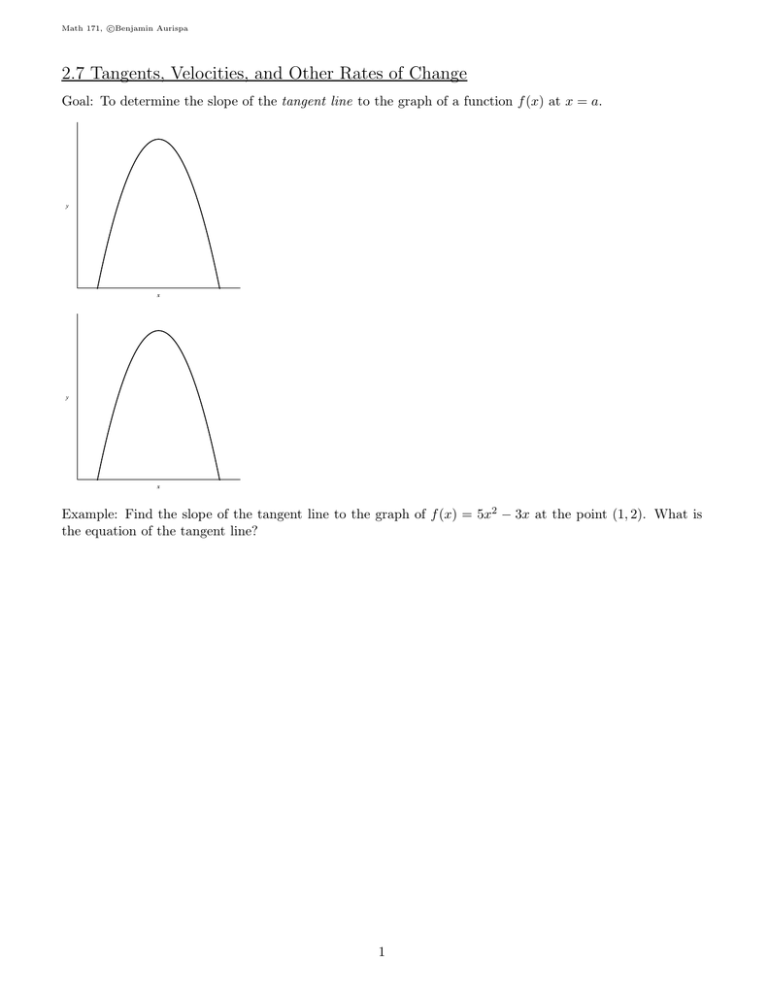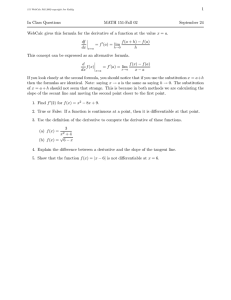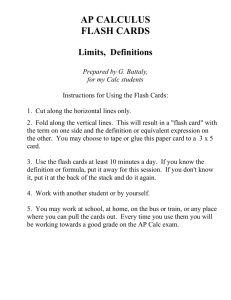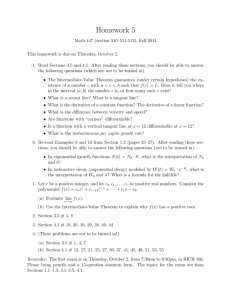Document 10504294
advertisement

c Math 171, Benjamin Aurispa 2.7 Tangents, Velocities, and Other Rates of Change Goal: To determine the slope of the tangent line to the graph of a function f (x) at x = a. Example: Find the slope of the tangent line to the graph of f (x) = 5x2 − 3x at the point (1, 2). What is the equation of the tangent line? 1 c Math 171, Benjamin Aurispa Example: Find the equation of the tangent line to the graph of f (x) = 2 4 at x = 5. x−2 c Math 171, Benjamin Aurispa Application: Suppose the displacement of an object in linear motion (1-dimensional motion) at time t is given by the function f (t), called the position function. This function (sometimes referred to as s(t)) represents the displacement of the bject from the origin at time t – not the actual path of the object. s 4 2 t 3 6 9 12 15 −2 The average velocity of the object from t = a to t = b is vavg = f (b) − f (a) ∆position = ∆time b−a (Slope of secant line) The instantaneous velocity of the object at time t = a is f (a + h) − f (a) h→0 h v(a) = lim or f (t) − f (a) t→a t−a lim (Slope of tangent line) An object is at rest when its instantaneous velocity is 0. This occurs when the slope of the tangent line is 0. Example: 1 The position of an object moving in a straight line at time t is given by the function f (t) = √ . t+1 (a) What is the average velocity of the object over the time interval from t = 3 to t = 8? (b) What is the instantaneous velocity of the object at time t = 4? 3 c Math 171, Benjamin Aurispa The same ideas above hold for vector functions. If r(t) is a vector function, then the tangent vector to the curve at the point P determined by t = a is given by v = lim t→a r(t) − ra) t−a or equivalently v = lim h→0 r(a + h) − r(a) h Example: Find a vector tangent to the curve r(t) = 8t − t2 , 3t at the point (15, 9). If an object is in 2-dimensional motion, then the position of an object can be modeled by a vector function r(t). In this case, the graph of the vector function is literally the path of the object. If the vector function above represented the path of an object after t seconds, then we would say the (instantaneous) velocity of the object at time t = 3 is is h2, 3i. For other applications, the underlying ideas hold: The average rate of change of the function f (x) from x = a to x = b is f (b) − f (a) b−a The instantaneous rate of change of the function f (x) at x = a is f (x) − f (a) x→a x−a lim f (a + h) − f (a) h→0 h or lim 4 c Math 171, Benjamin Aurispa 3.1 Derivatives Definition of the Derivative (at a point): The derivative of a function f at a number a, denoted f ′ (a), is f (a + h) − f (a) h→0 h f ′ (a) = lim or equivalently f (x) − f (a) x→a x−a f ′ (a) = lim We have already seen all of this in the previous section! The derivative of a function at a has the following interpretations: • f ′ (a) is the slope of the tangent line to the graph of f at x = a. • f ′ (a) is the instantaneous rate of change of the function f at x = a. • If f (t) is a position function, then f ′ (a) is the instantaneous velocity at time t = a. Either of the above formulas can be used to find the derivative of a function at a specific value x = a. We did many examples of this in the previous section. We can also find a function that will give the derivative at all values of x for which it is defined. Definition of the Derivative (as a function): If f is a function, the derivative of f , denoted f ′ is f (x + h) − f (x) h→0 h f ′ (x) = lim Example: Find the derivative of f (x) = x+1 . 2x − 1 What is the slope of the tangent line at x = 1? 5 c Math 171, Benjamin Aurispa Example: Find f ′ (x) if f (x) = √ 1 − 3x. There are many different notations for the derivative of a function. If y = f (x), the following notations denote the derivative of f : d dy df , , f (x) f ′ (x), y ′ , dx dx dx Taking the derivative of a function is also referred to as differentiation. A function is differentiable at a if f ′ (a) exists. If the position function of an object is given by f (t) = t2 − 3t, find the velocity function. 6 c Math 171, Benjamin Aurispa Theorem: If f is differentiable at a, then f is continuous at a. Note: The converse is NOT true. If f is continuous at a, it may not be differentiable at a. A function is not differentiable at: • Discontinuities • Corners • Vertical tangent lines Where is the following function not differentiable? 6 4 2 −6 −4 −2 2 4 6 8 10 14 −2 −4 −6 Example: Where is the function f (x) = |x2 − 9| not differentiable? 7 16 c Math 171, Benjamin Aurispa Example: Show using limits why the function f (x) = |4x − 8| is not differentiable at x = 2. Given the graph of f below, sketch a graph of f ′ . 10 8 6 4 2 2 4 6 8 10 12 14 16 18 2 4 6 8 10 12 14 16 18 8








